Simple Screencast Production Tips for Better E-Learning
Since the screencast videos will be briefer and tied to specific actions there may be some learning openings or other things the person wants to know. It’s always a great idea to curate a list of tools for the viewer after they’ve completed the screencast video to get.
What are people supposed to do with the program? Make a list of responsibilities or required actions. Then build your screencasts about goals and how to meet them. Give challenges and the way they are met by the program to them.
Screencast Tip: Keep it Short
Screencast Tip: Focus on Action
Published at Tue, 29 Aug 2017 11:08:15 +0000

The more practice, the more fluent they’ll be. This is key with software training where you build on skills from previous coaching videos.
Tutorials are some of the most frequent types of online training. This makes sense since a big part of e-learning is predicated on learning new applications. One challenge is currently creating engaging and effective screencasts. Today, we’ll look that will help you get started.
Screencast Tip: Don’t Focus on Features
Screencast Tip: Don’t Make a Screencast
It helps to understand what you are learning and why. At the start of the screencast, introduce what you are going to teach and why (or what the outcome should be). Many screencasts are not about what the value of this screencast is clear. They either jump free of context into instruction, or they spend too much time on content that is non-essential.
As Archie Bunker used to say, “Get to the point, Edith.”
Screencast Tip: Don’t Stop at One
People need opportunities. Many screencasts and the activities are based on one action. Use as you introduce new abilities the actions to reinforce a previous lesson. Give them opportunities to review and repeat the procedure.
Many of the screencasts I view undergo a feature list. They spend way too much time on the user interface and the features. You don’t need to explain everything in the program or everything you can do with it. And not all features are created equal. Some are used all of the time and some rarely.
Skip the dissertation that is feature-by-feature. Focus on the key the ones most critical to the user’s objectives and aspects.

What tips do you need to share?
Join us for one or two days of e-learning goodness. Day 1 focuses on subjects that are e-learning that are general and Day 2 is on learning to build some interactions that are nice, reusable centered. They’re great activities that will help you learn more. Subscribe using the links below. Seats are limited for the events. If you are interested in presenting at one of the roadshows, allow me to know. Early bird rate expires August 28.
Free E-Learning Resources
The other day I was reviewing a product video for some gadget. The movie was about seven minutes long. I wanted to understand the gadget worked and what features it had but the man spent the first three minutes talking about a bunch of crap that had nothing.
Here are some additional resources for those who want to create screencasts:
Shorter videos are better. It’s much better to have a collection of videos than to have one one which compels the user to scrub. Try to stay focused on one objective.
I enjoy this interactive screenshot prototype which David built a while ago. It looks great and it’s simple to construct. It’s also available as a free download.
Screencasts take time and some require edits. And if the content changes (like a new interface or features) then they will need to be redone. Often use labels to highlight areas and it is easier to display a screen. These are easier to update when the subject matter remains in flux. And it helps when they need information that is simple, you avoid videos.
By way of instance, if I were teaching someone how to use a spreadsheet, instead of showing them how to to use certain features, I’d begin with a real-world challenge: “You need to create a report using this data.” And from there, Iconcentrate on the features relevant to the objective and’d go through the process of education.
Source: TPD Study Tips Feed

Leave a Reply